⚡ Quick Summary
- Top Treatments: Minoxidil (₹800-2K/month), PRP Therapy (₹8-15K/session), Low-Level Laser Therapy (₹3-8K/session)
- Budget Range: Premium comprehensive plan: ₹1.5-3L annually | Budget-friendly: ₹15K-30K annually
- Best Age to Start: At first signs of thinning (usually 25-35)
- Most Cost-Effective: Minoxidil + Finasteride (₹1,500-3,000/month) stops 90% of male pattern baldness
- Results Timeline: Medical treatments (3-6 months), PRP (2-4 months), Hair transplant (8-12 months)
- Indian Hair Considerations: Higher DHT sensitivity requires early intervention
Introduction: Understanding Hair Fall in the Indian Context
Hair fall is more than just a cosmetic concern—it affects confidence, self-image, and quality of life. If you've been watching more hair in your drain than on your head, you're not alone. Studies show that 60% of Indian men experience significant hair loss by age 35, and increasingly, women are joining these statistics too. But here's the good news: we're living in the golden age of hair restoration, with more proven, accessible treatments than ever before.
"The biggest mistake I see with hair fall patients is waiting too long to seek treatment. Hair follicles don't regenerate once they're gone—they go dormant. Early intervention is everything. With the right combination of medical and procedural treatments, we can stop progression in 85-90% of cases and achieve significant regrowth in about 60%."
Indian hair has its own unique characteristics—typically thicker individual strands but with different growth patterns and higher sensitivity to DHT (the hormone responsible for pattern baldness). Research shows that ethnic hair requires specialized approaches to minimize risks. This guide cuts through the noise to give you science-backed treatments that actually work for Indian hair, complete with realistic timelines, costs, and what to expect.
🏆 The Top 8 Hair Fall Treatments: Ranked by Effectiveness
Based on clinical studies, trichologist consensus, and real patient outcomes for Indian hair. This isn't about miracle cures—it's about what dermatologists actually prescribe and what works.
Minoxidil (Topical Solution)
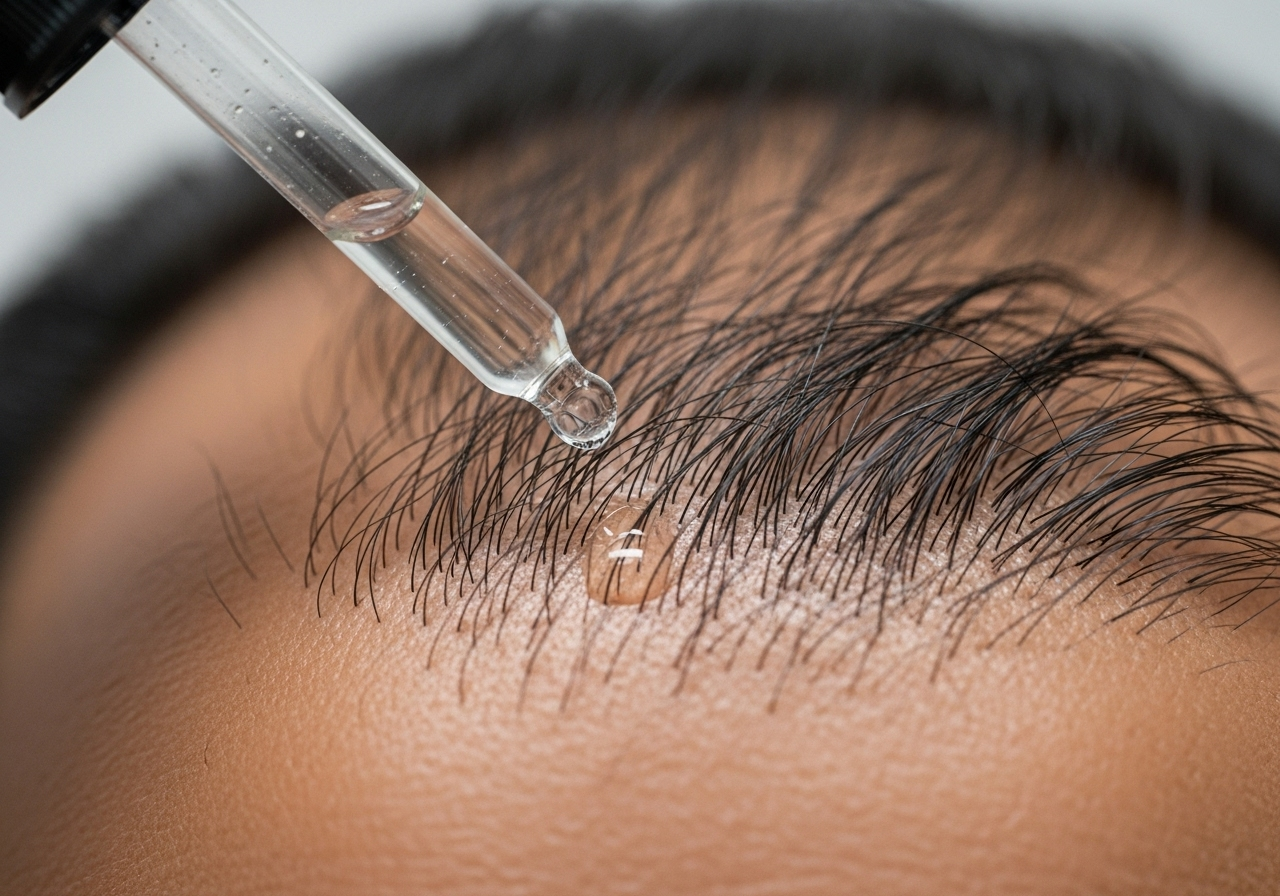
Minoxidil 5% solution application - the FDA-approved topical treatment for hair loss, shown on Indian skin tone
What it is: Think of minoxidil as a wake-up call for sleepy hair follicles. This FDA-approved topical solution increases blood flow to your scalp, extends the growth phase of hair, and gradually awakens dormant follicles back to life.
Best for: Male and female pattern baldness, thinning crown, receding hairline, overall hair density
Results: Initial shedding phase (1-2 months), visible regrowth starts at 3-4 months, peak results at 8-12 months
Cost: ₹800 - ₹2,000 per month
How to use: Apply 1ml twice daily to dry scalp (5% for men, 2-5% for women)
Downtime: None (may cause initial shedding)
⚠️ Important to Know
Initial shedding is normal: 60-70% of users experience increased shedding in weeks 2-8. This is actually a good sign—weak hairs falling out to make room for stronger ones.
Lifetime commitment: Results disappear within 3-4 months of stopping treatment
Not for: Pregnant/breastfeeding women, those with heart conditions (consult doctor first)
Finasteride (Oral Medication) - For Men Only
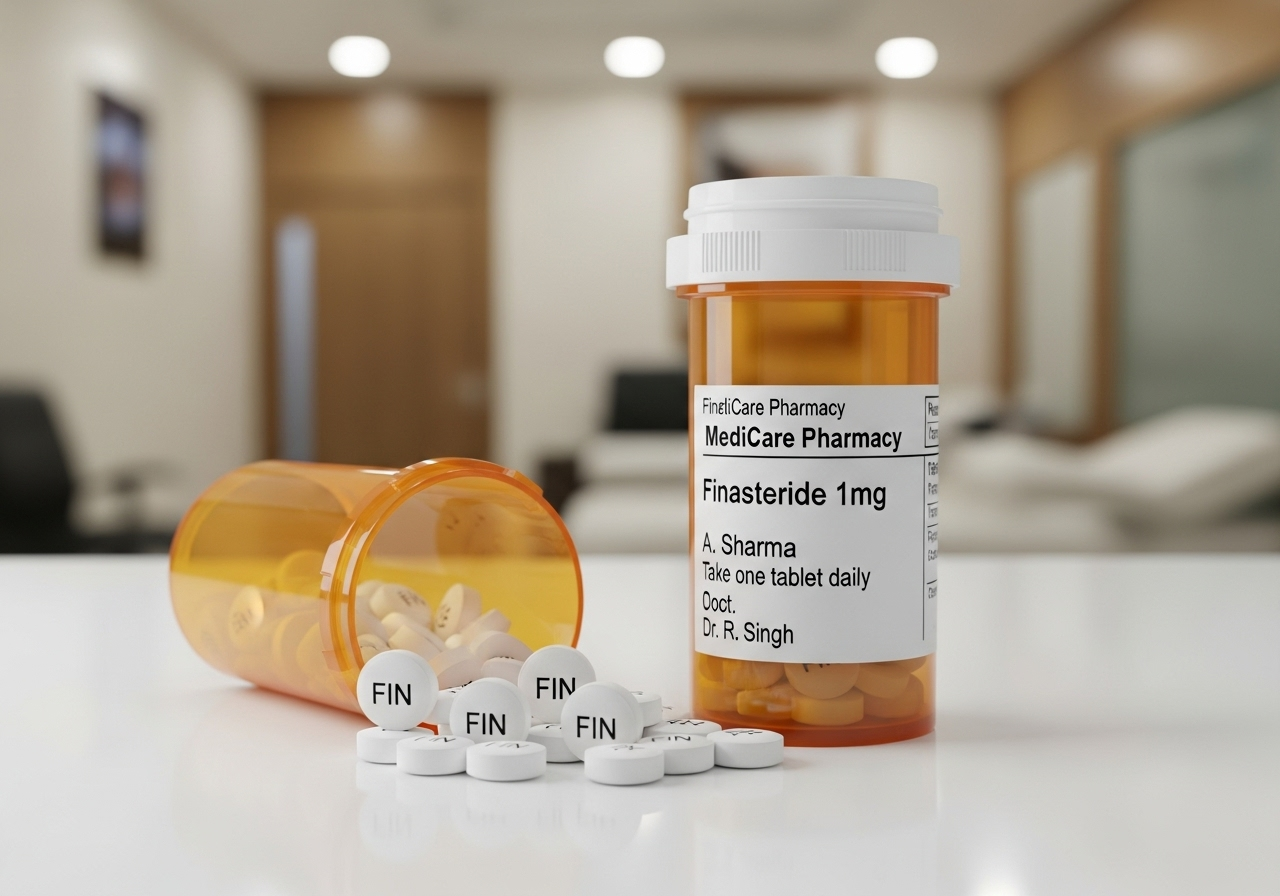
Finasteride 1mg tablets - prescription medication that blocks DHT to prevent hair loss in men
What it is: Finasteride blocks the conversion of testosterone to DHT (dihydrotestosterone), the hormone that shrinks hair follicles in genetically susceptible men. Think of it as turning down the volume on the hormone attacking your hair.
Best for: Male pattern baldness, crown thinning, receding hairline, prevention
Results: Hair loss stops in 3-6 months, regrowth visible at 6-12 months
Cost: ₹300 - ₹1,200 per month (prescription required)
How to use: 1mg tablet daily (oral)
Downtime: None
⚠️ Men Only - Important Safety Information
Not for women: Finasteride is contraindicated for women, especially those of childbearing age
Prescription required: Must be prescribed by a qualified dermatologist or trichologist
Potential side effects: Sexual side effects occur in 2-5% of users (usually temporary). Discuss thoroughly with your doctor.
Regular monitoring: Some doctors recommend periodic blood tests
PRP (Platelet-Rich Plasma) Therapy
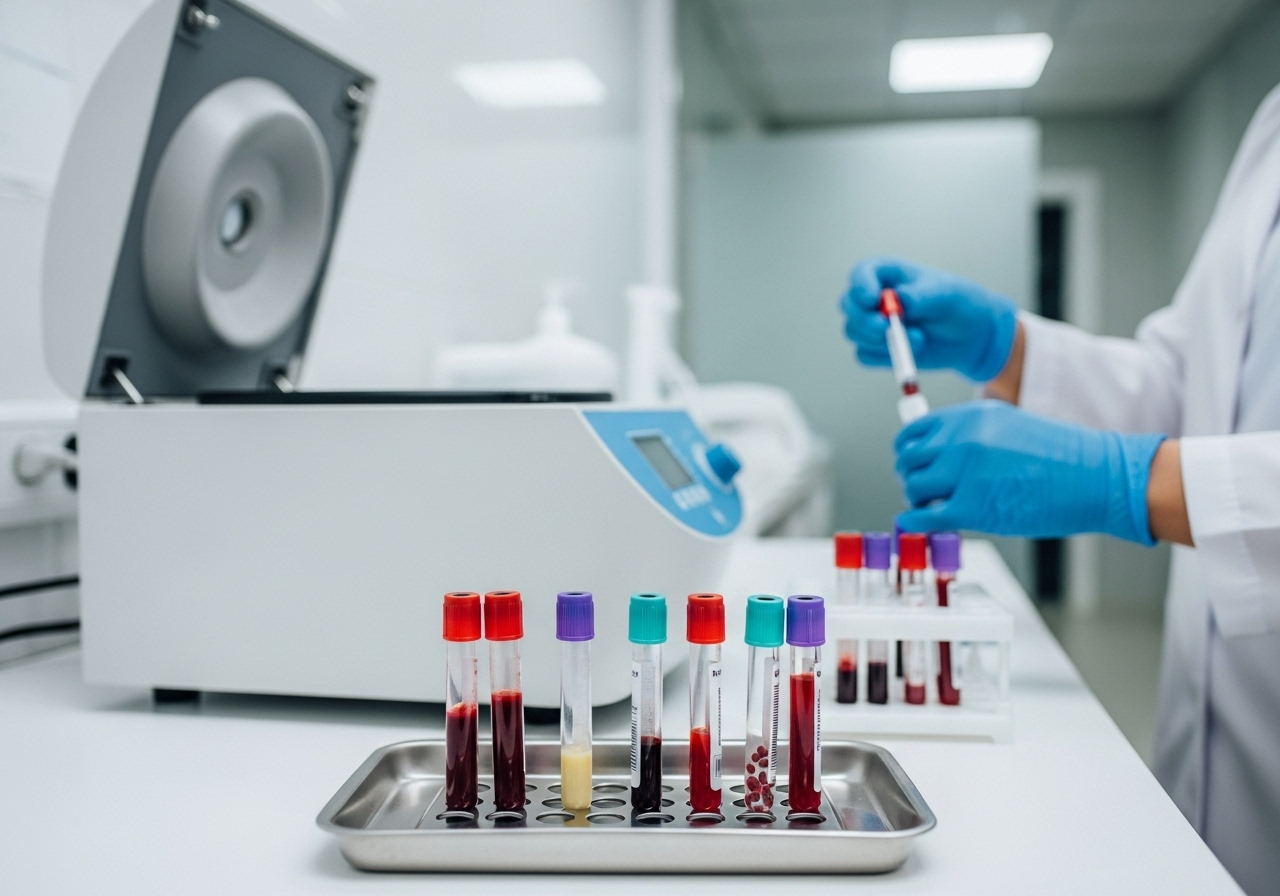
PRP therapy preparation - your own blood platelets concentrated and used to stimulate hair growth
What it is: Your own blood is drawn, spun in a centrifuge to concentrate the healing platelets, then injected into your scalp. These platelets release growth factors that stimulate dormant follicles and strengthen existing hair. It's like fertilizer for your hair.
Best for: Androgenetic alopecia, hair thinning, hair density improvement, maintenance after transplant
Results: Reduced shedding in 4-6 weeks, new hair growth visible at 2-4 months, best results at 6 months
Cost: ₹8,000 - ₹15,000 per session
Sessions needed: 4-6 initial sessions (monthly), then maintenance every 4-6 months
Downtime: Minimal (mild tenderness for 1-2 days)
Low-Level Laser Therapy (LLLT)
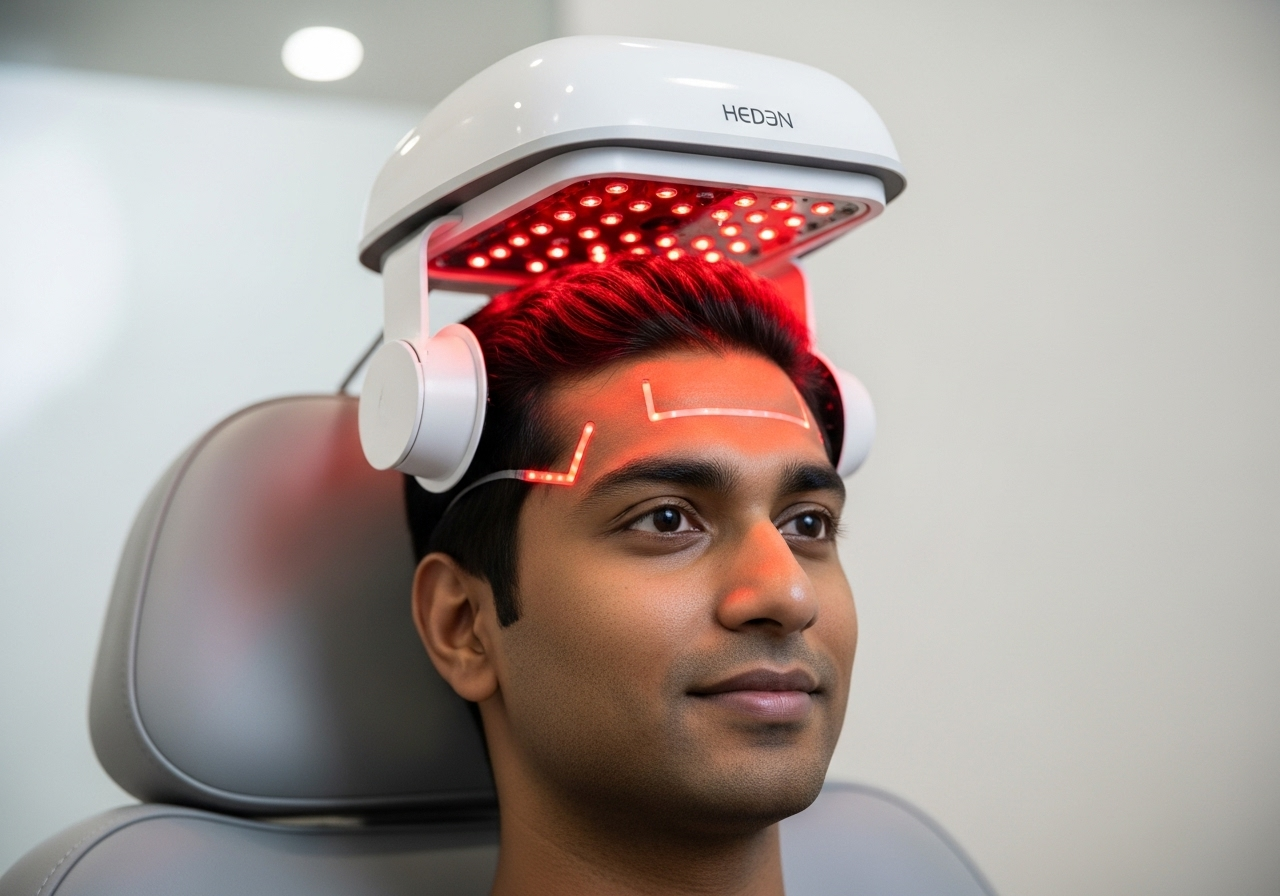
LLLT laser therapy cap - FDA-cleared red light treatment that energizes hair follicles at cellular level
What it is: Red light at specific wavelengths penetrates the scalp to energize hair follicles at a cellular level, increasing ATP production (cellular energy) and blood flow. It's like giving your follicles a daily vitamin boost.
Best for: Androgenetic alopecia, overall hair thinning, complementary treatment
Results: Reduced shedding in 8-12 weeks, improved density in 4-6 months
Cost: In-clinic sessions: ₹3,000 - ₹8,000 per session | At-home devices: ₹15,000 - ₹50,000 (one-time)
Sessions needed: 2-3 times weekly (ongoing)
Downtime: Zero
Hair Transplant (FUE/FUT)
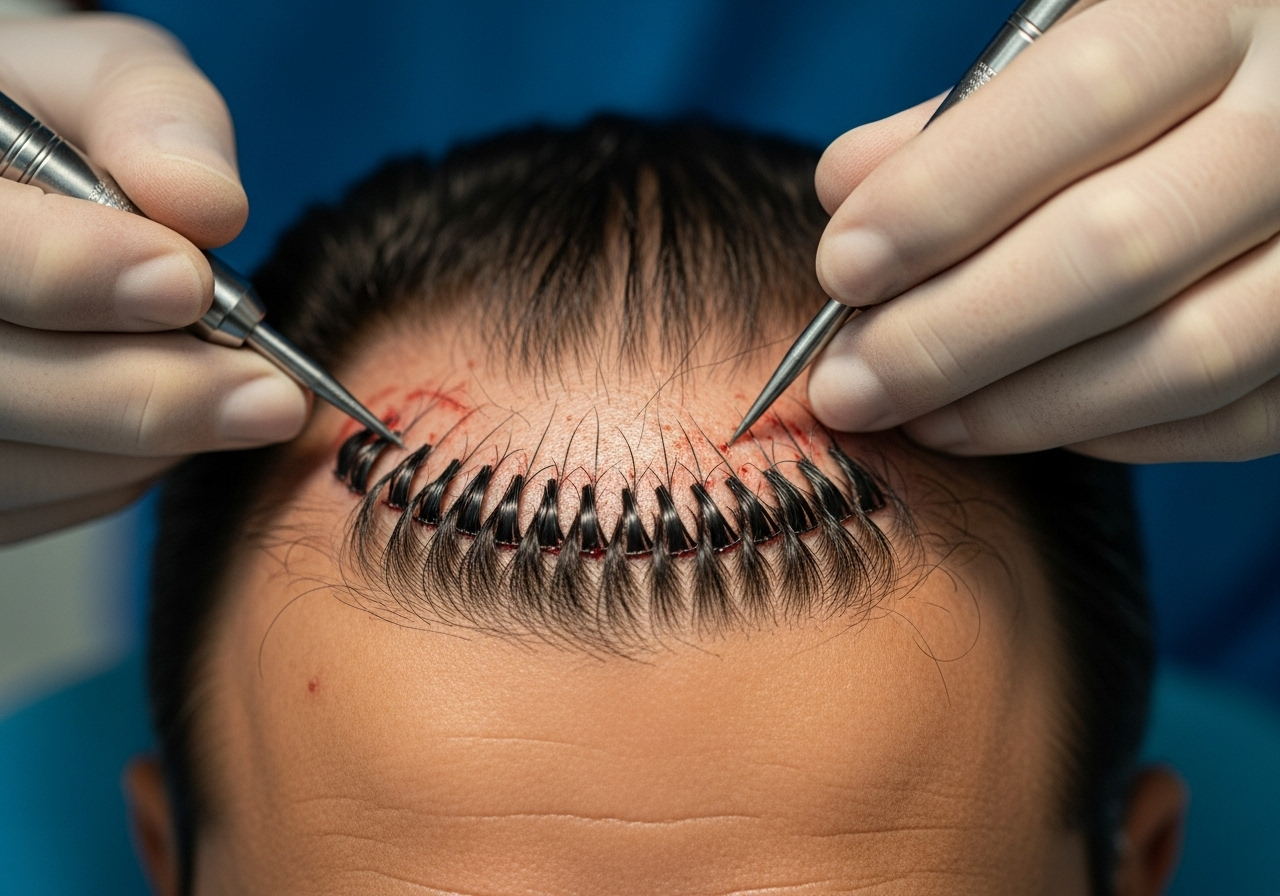
FUE hair transplant procedure - follicular units being extracted and transplanted for permanent hair restoration
What it is: Hair follicles are harvested from the back and sides of your head (the "permanent zone" resistant to DHT) and transplanted to thinning or bald areas. Think of it as redistributing your assets—moving hair from where you have plenty to where you need it most.
Best for: Advanced baldness, receded hairline, crown thinning, permanent solution
Results: Transplanted hair sheds in 2-3 weeks (normal!), new growth starts at 3-4 months, visible improvement at 6 months, final results at 12-18 months
Cost: ₹40,000 - ₹1,50,000 (depends on number of grafts: typically 1,000-3,000 grafts needed)
Technique: FUE (no linear scar, slower recovery) or FUT (linear scar, faster harvest)
Downtime: 7-10 days (avoid strenuous activity, visible scabbing)
⚠️ Critical Considerations
Not a cure: Transplanted hair is permanent, but existing non-transplanted hair can still thin. Most surgeons recommend continuing finasteride/minoxidil to protect remaining hair.
Choose wisely: Hair transplant results are only as good as the surgeon. Research extensively—look for board-certified dermatologists or plastic surgeons with 500+ successful transplants. Bad transplants are extremely difficult to fix.
Realistic expectations: You need adequate donor hair. Not everyone is a candidate.
Dutasteride (Oral Medication) - For Men Only
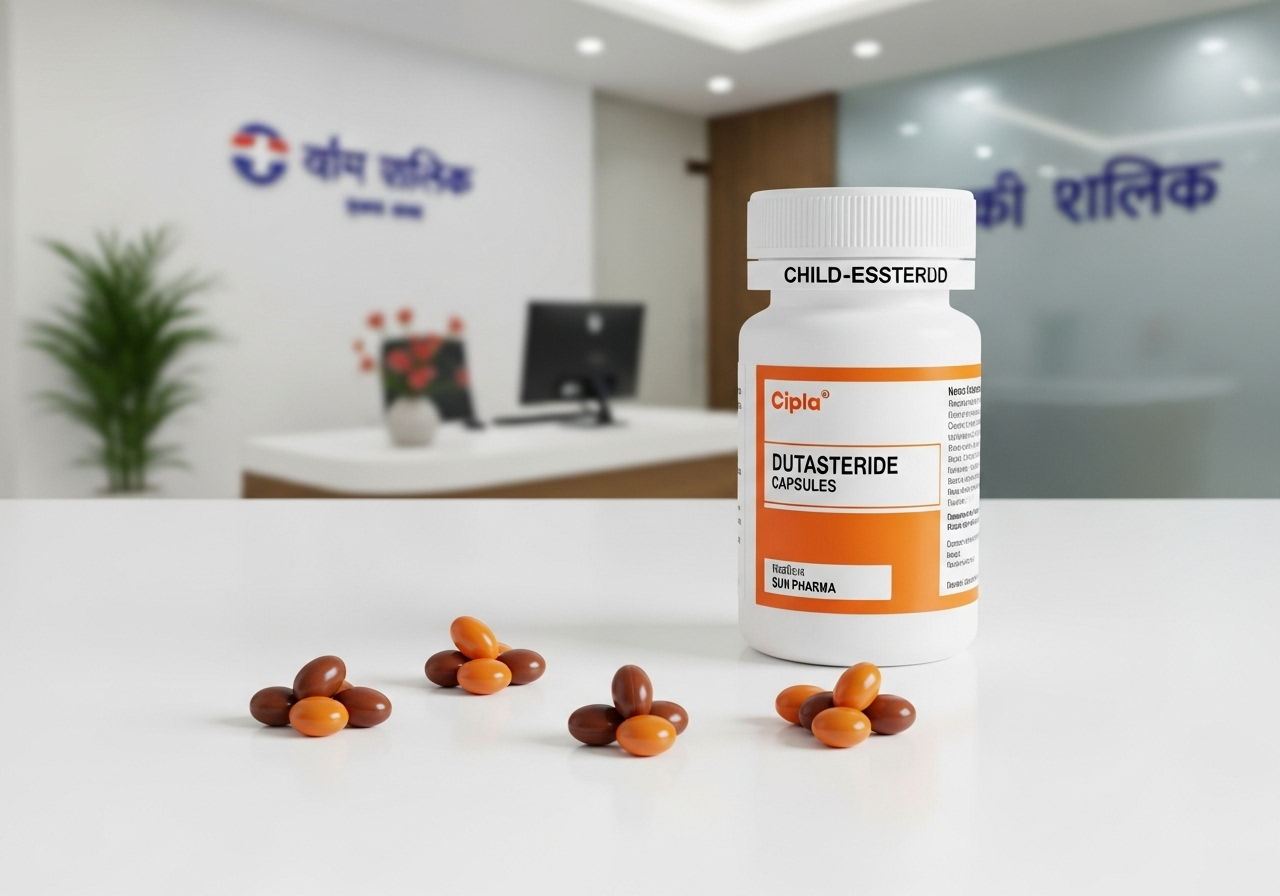
Dutasteride 0.5mg - stronger DHT blocker for men who need more aggressive hair loss prevention
What it is: Like finasteride's stronger cousin, dutasteride blocks both Type I and Type II forms of the enzyme that converts testosterone to DHT, providing more complete DHT suppression.
Best for: Men who don't respond adequately to finasteride, aggressive hair loss
Results: Similar to finasteride but potentially more effective (20-30% better DHT reduction)
Cost: ₹400 - ₹1,500 per month (prescription required)
How to use: 0.5mg daily (oral)
Downtime: None
⚠️ For Advanced Cases Only
Not first-line: Most dermatologists start with finasteride. Dutasteride is reserved for non-responders.
Same contraindications as finasteride: Men only, prescription required, potential sexual side effects (similar rate to finasteride)
Longer half-life: Stays in system longer than finasteride
Microneedling with Minoxidil
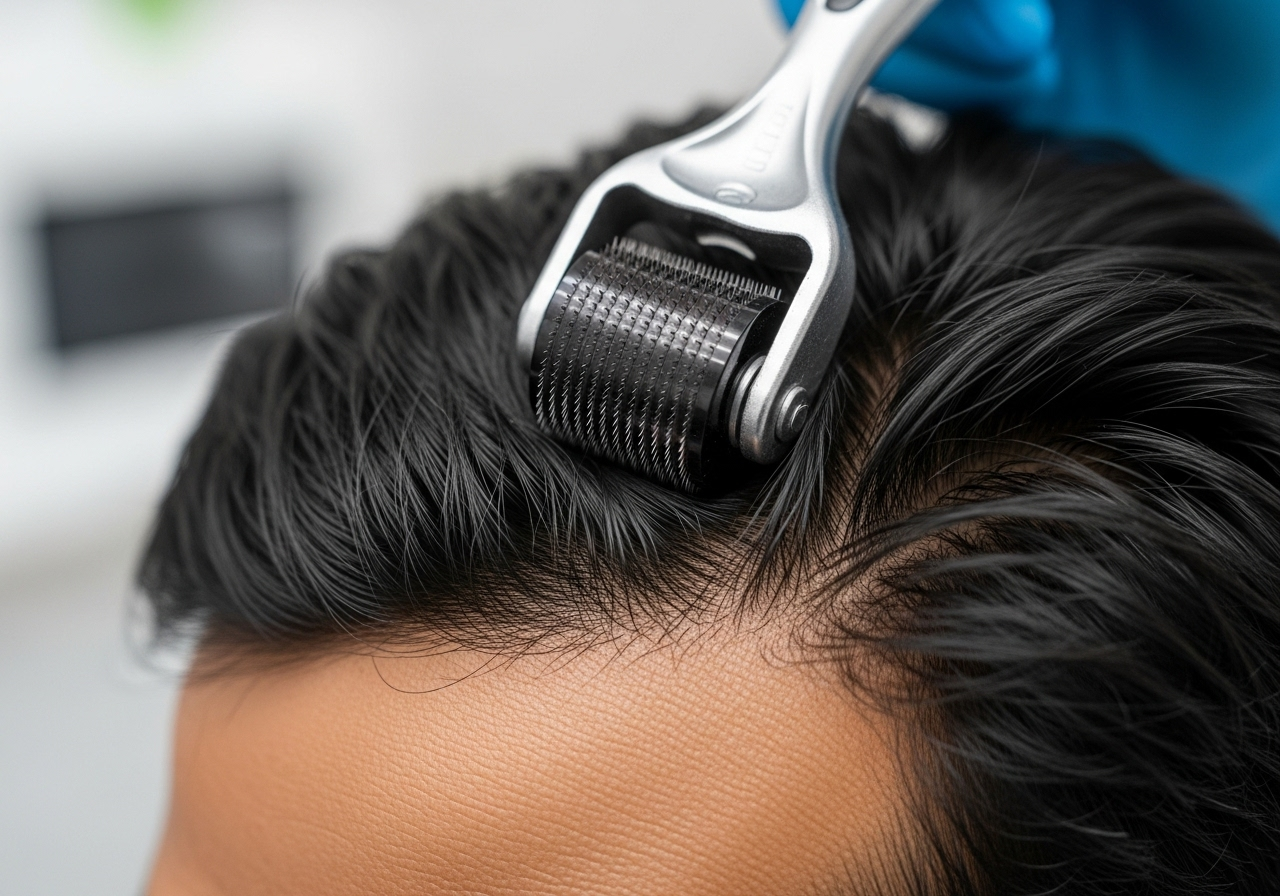
Microneedling scalp treatment - derma-roller creating micro-channels to boost minoxidil effectiveness by 4x
What it is: A derma-roller or dermapen creates thousands of tiny micro-channels in the scalp, which does two things: stimulates healing growth factors AND dramatically increases absorption of topical minoxidil. It's like aerating your lawn before fertilizing.
Best for: Boosting effectiveness of minoxidil, stubborn hair loss, overall density
Results: Studies show 4x better results when combining microneedling with minoxidil vs. minoxidil alone
Cost: At-home derma-roller: ₹500-2,000 | Professional sessions: ₹3,000-8,000 per session
Sessions needed: Once weekly (at-home 0.5-1mm) or monthly (professional 1.5-2mm)
Downtime: Mild redness for 24 hours
Topical Finasteride + Minoxidil Combination
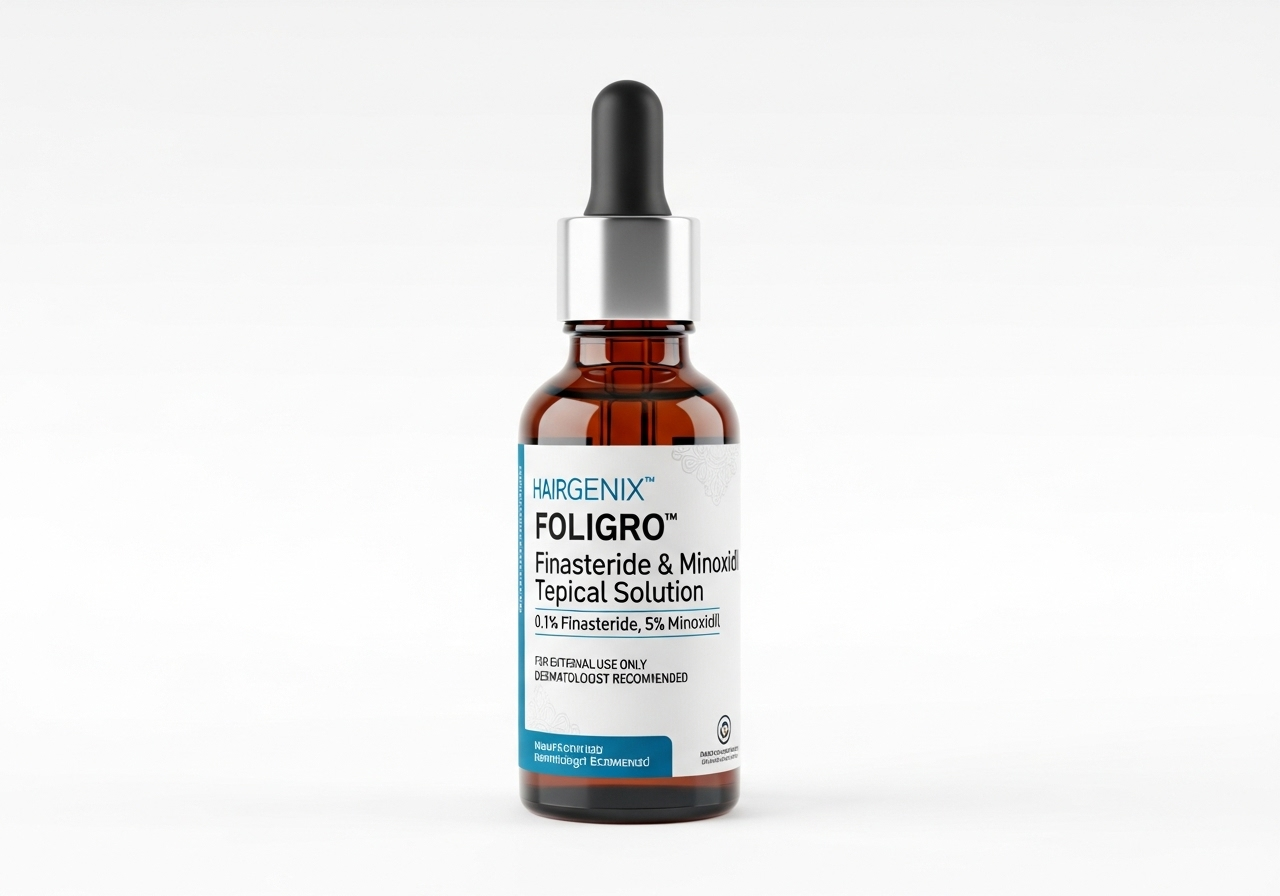
Topical combination therapy - finasteride + minoxidil in one solution for reduced systemic side effects
What it is: A newer approach that combines finasteride and minoxidil in one topical solution, offering the benefits of both treatments while potentially reducing systemic side effects of oral finasteride.
Best for: Men who want finasteride's benefits but worry about systemic side effects
Results: Similar efficacy to oral finasteride + topical minoxidil, with lower systemic absorption
Cost: ₹1,500 - ₹3,500 per month (prescription compounded solution)
How to use: Apply once or twice daily as prescribed
Downtime: None
💰 Budget Planning: Creating Your Hair Restoration Plan
Hair fall treatment is a marathon, not a sprint. Here are three realistic budget frameworks for different commitment levels:
Budget-Friendly Plan (₹15,000 - ₹30,000/year)
- Minoxidil 5%: ₹1,000/month = ₹12,000/year
- Finasteride 1mg: ₹600/month = ₹7,200/year
- Derma-roller (at-home): ₹1,500 (one-time)
- Total Year 1: ₹20,700
Best for: Early-stage hair loss, prevention, limited budget
Comprehensive Plan (₹80,000 - ₹1,50,000/year)
- Minoxidil + Finasteride: ₹1,800/month = ₹21,600/year
- PRP Therapy: 6 sessions × ₹10,000 = ₹60,000
- LLLT at-home device: ₹25,000 (one-time)
- Professional dermatologist visits: ₹15,000/year
- Total Year 1: ₹1,21,600
Best for: Moderate to advanced hair loss, desire for faster results
Premium Plan with Transplant (₹2,00,000 - ₹3,50,000)
- FUE Hair Transplant: ₹1,50,000 - ₹2,50,000 (one-time)
- Post-transplant PRP: 4 sessions × ₹10,000 = ₹40,000
- Maintenance medications: ₹20,000/year
- Total Year 1: ₹2,10,000 - ₹3,10,000
Best for: Advanced baldness, desire for permanent solution
📅 Treatment Timeline: When to Start What
Timing matters. Here's the optimal treatment sequence based on age and hair loss stage:
🎯 Ages 20-30: Prevention Phase
- First signs of thinning? Start minoxidil immediately
- Family history of baldness? Consider low-dose finasteride (0.5mg)
- Budget allows? Add LLLT for prevention
- Timeline: Commit for at least 12 months to see full results
🎯 Ages 30-40: Active Treatment Phase
- Month 1-3: Start minoxidil + finasteride (expect initial shedding)
- Month 2: Add weekly microneedling
- Month 3-8: Begin PRP series (monthly sessions)
- Month 6: Evaluate results, adjust protocol
- Month 12: Consider LLLT if plateau reached
🎯 Ages 40+: Aggressive Treatment or Transplant
- Extensive baldness: Hair transplant consultation first
- Pre-transplant: Start finasteride 6 months before surgery
- Post-transplant: Continue medications + PRP for optimal graft survival
- Not ready for transplant: Max medical therapy (minoxidil + dutasteride + PRP + LLLT)
🚫 What Doesn't Work: Save Your Money
Let's cut through the noise. Here's what the evidence says you should avoid:
❌ Biotin Supplements (Unless Deficient)
Unless you have a diagnosed biotin deficiency (extremely rare), biotin supplements won't help hair loss. Study after study shows no benefit for typical pattern baldness. Save your ₹1,500/month.
❌ Most Hair Growth Shampoos
That ₹2,000 "anti-hair fall" shampoo? Marketing magic. Shampoo rinses off in minutes—not enough contact time for active ingredients to work. The exception: Ketoconazole shampoo (2%) has some evidence for reducing scalp inflammation.
❌ Unproven Stem Cell Treatments
Many clinics market "stem cell therapy" for hair loss. The science isn't there yet. These treatments cost ₹50,000-₹1,00,000 with zero quality evidence. Stick with proven PRP instead.
❌ Essential Oils as Standalone Treatment
Rosemary oil, peppermint oil—they smell nice and may provide minimal benefits, but they're not replacing medical treatments. Use them if you enjoy them, but not instead of minoxidil.
🔬 The Science: Why Indian Hair Falls Out
Understanding the enemy helps you fight it. Here are the main culprits:
1. Androgenetic Alopecia (Pattern Baldness) - 85% of Male Hair Loss
Your hair follicles are genetically sensitive to DHT. Over time, DHT miniaturizes the follicles until they produce only fine, baby hair, then eventually stop completely. This is why early intervention matters—once follicles are gone, they're gone.
2. Telogen Effluvium (Stress/Shock-Related Shedding)
Major stress, illness, surgery, or nutritional deficiencies push hair follicles into the resting (telogen) phase prematurely. Good news: usually temporary and self-correcting within 6-12 months.
3. PCOS & Hormonal Issues (Women)
Polycystic ovary syndrome causes elevated androgens in women, leading to hair thinning similar to male pattern baldness. Requires hormonal treatment in addition to topical solutions.
4. Nutritional Deficiencies
Iron deficiency (especially in vegetarian women), vitamin D deficiency, and protein malnutrition can all trigger hair shedding. Blood tests can identify these—and they're easily fixable.
🏥 Finding the Right Specialist in India
Not all hair loss treatment providers are created equal. Here's how to find quality care:
✅ Look For:
- Board-certified dermatologist or trichologist with recognized credentials
- Before/after photos of actual patients (not stock photos)
- Realistic promises ("stop hair loss" is realistic; "regrow all hair" is not)
- Customized treatment plans based on your specific pattern and stage
- Transparent pricing with no hidden costs
🚩 Red Flags:
- Guaranteeing 100% results or "miracle cures"
- Pushing expensive proprietary treatments without evidence
- Starting with transplant before trying medical management
- No proper consultation or hair analysis
- Extremely cheap transplants (often means inexperienced surgeon or technician-performed surgery)
🌆 Top Cities for Hair Loss Treatment in India
Mumbai: Largest concentration of experienced hair transplant surgeons, premium pricing
Delhi/NCR: Excellent options, slightly lower costs than Mumbai
Bangalore: Growing hub with modern clinics, competitive pricing
Hyderabad: Quality care with most affordable pricing among metros
Jaipur: Known for specific high-quality transplant centers, worth traveling for
💡 Expert Tips for Maximum Results
- Consistency is everything: Treatments only work while you use them. Missing applications tanks results.
- Photograph your progress: Same lighting, same angle, monthly. Hair changes are subtle—photos reveal what mirrors miss.
- Combine treatments: Minoxidil + finasteride works better than either alone. Add PRP for even better results.
- Manage expectations: You're trying to stop loss and regrow some hair—not restore your teenage hairline.
- Start early: The earlier you start, the more follicles you save. Waiting never improves outcomes.
- Fix the basics first: Get blood work (iron, vitamin D, thyroid, testosterone). Treat deficiencies.
- Reduce scalp inflammation: Use ketoconazole shampoo 2-3x weekly. Scalp inflammation accelerates hair loss.
- Protect from sun: Wear a hat. UV damage to the scalp accelerates follicle aging.
❓ Frequently Asked Questions
Q: Can hair loss be completely reversed?
A: It depends on the stage. If follicles are miniaturized but not dead, treatments can reverse thinning. Once follicles are completely dormant (bald for 5+ years), only transplant works. Early intervention is key.
Q: How long before I see results?
A: Minoxidil: 4-6 months | Finasteride: 6-12 months | PRP: 3-4 months | Hair transplant: 8-12 months. Hair grows slowly—patience is mandatory.
Q: Will I have to use these treatments forever?
A: Yes, for medical treatments (minoxidil, finasteride). They maintain results but don't cure the underlying genetic sensitivity to DHT. Stop treatment = hair loss resumes. Hair transplants are permanent, but you may still need medications to protect non-transplanted hair.
Q: Are finasteride side effects really that common?
A: Clinical trials show sexual side effects in 2-5% of users (vs. 1-2% in placebo groups). Most are mild and resolve even with continued use. The internet amplifies the negative experiences. Discuss frankly with your dermatologist.
Q: What about women—can they use these treatments?
A: Women can use: minoxidil (2-5%), PRP, LLLT, microneedling. Women should NOT use: finasteride, dutasteride (especially if pregnant/breastfeeding). Women have different treatment protocols—consult a dermatologist.
Q: How do I know if I'm a good candidate for hair transplant?
A: You need adequate donor hair (back and sides), stable hair loss pattern (not actively shedding everywhere), realistic expectations, and good general health. A consultation with an experienced surgeon will determine candidacy.
🎯 Conclusion: Your Action Plan
Hair loss is emotionally challenging, but you're not powerless. The treatments in this guide are backed by decades of research and countless success stories from Indian patients. Here's your immediate action plan:
🚀 Next Steps:
- Get evaluated: See a board-certified dermatologist for proper diagnosis and hair analysis
- Start medical treatment early: Don't wait. Begin minoxidil (and finasteride for men) as soon as possible
- Set realistic timelines: Commit to 12 months before judging results
- Track progress: Monthly photos, same conditions, same angle
- Consider combination therapy: Medications + PRP or LLLT for enhanced results
- Stay consistent: Missing treatments destroys results. Build it into your daily routine
- Evaluate at 6 months: If no improvement, reassess with your dermatologist and adjust protocol
Remember: the best time to start treating hair loss was 5 years ago. The second-best time is today. The science is on your side, the treatments work, and every month you wait is a month of follicles you could have saved.
Ready to take action? Your future hair thanks you.
Medical Disclaimer: This blog is for informational purposes only and should not replace professional medical advice. Always consult with a board-certified dermatologist or trichologist before starting any hair loss treatment. Individual results vary based on genetics, age, extent of hair loss, and treatment adherence. Prices mentioned are approximate and may vary by location and clinic.
